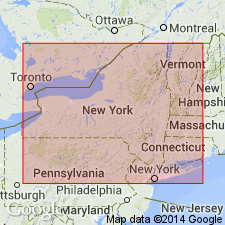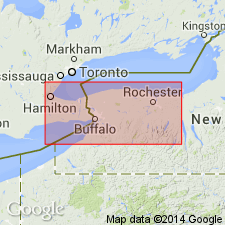
- Usage in publication:
-
- Second Creek Bed
- Modifications:
-
- Named
- Dominant lithology:
-
- Phosphorite
- AAPG geologic province:
-
- Appalachian basin
Summary:
The basal phosphatic-quartz pebble bed of the Williamson Shale (Clinton Group) is here named the Second Creek Bed for exposures along Second Creek, north of Alton, Wayne Co., NY. The lower part of the bed is stained red and contains abundant pyrite, phosphatic pebbles, and quartz granules. Upper part is characterized by phosphatic pebbles, quartz granules, and abundant brachiopods. Thickness at the type section is 3 to 6 cm; elsewhere thickness ranges to 20 cm. Irregular lower contact with the Sodus Shale marked by scour and fill structures. Unit is laterally equivalent to the Westmoreland Iron Ore at the base of the Willowvale Shale. Age is Early Silurian (Llandoverian).
Source: GNU records (USGS DDS-6; Reston GNULEX).

- Usage in publication:
-
- Second Creek Phosphate Bed*
- Modifications:
-
- Overview
- AAPG geologic province:
-
- Appalachian basin
Summary:
The Second Creek Phosphate Bed of the Williamson Shale is a quartzose and phosphatic granule- to pebble-sized conglomeratic lag deposit that can be pyritic, locally calcareous, and fossiliferous (abundant EOPLECTODONTA brachiopods). Unit is basal bed of Williamson Shale. Thickness is 0.1 to 0.7 feet. Unconformably overlies the Merritton Shale where it exists, otherwise overlies other Clinton Group units; underlies the green shales of the remainder of the Williamson Shale, but where shales are absent, unconformably underlies the Rockway Dolomite. The Second Creek is of Early Silurian (late Llandoverian) age. [Report uses Early and Late Silurian time scale of Harland and others (1982).]
Source: GNU records (USGS DDS-6; Reston GNULEX).
For more information, please contact Nancy Stamm, Geologic Names Committee Secretary.
Asterisk (*) indicates published by U.S. Geological Survey authors.
"No current usage" (†) implies that a name has been abandoned or has fallen into disuse. Former usage and, if known, replacement name given in parentheses ( ).
Slash (/) indicates name conflicts with nomenclatural guidelines (CSN, 1933; ACSN, 1961, 1970; NACSN, 1983, 2005, 2021). May be explained within brackets ([ ]).

